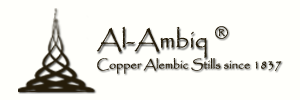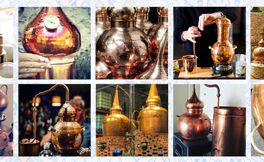Technical Data
Our company prides itself on maintaining the quality and standard we have become well known for and to which our customers have gotten used to.
We stand out because you can be assured that our products, as well as the materials we use in the manufacturing process are completely safe, tested and certified.
SOLDERING:
The solder applied to our alembics is copper, brass or tin-silver and all the valid EU regulations are respected. We guarantee our clients a perfectly safe construction that will not alter the pure and distinctive character of the distillate.
BRASS WIRE:
The top, belly and base of the alembic pot are soldered together at very high temperatures by means of brass wire. Brass is an alloy of zinc and copper and is well known for its strength and malleability. At the final stage these brass joints are hammered and hardened on a steel stake.
TIN-SILVER SOLDER:
The tin-silver solder is composed mostly of tin, small amounts of silver and some traces of copper. Tin melts easily at lower temperatures, provides good adherence to copper and it is not soluble in alcohol. This solder is applied to pipes, thermometer fixtures and where hammering is not possible.
Tin-silver solder is extremely safe and environment friendly, our solder may be considered cadmium and lead free and respects the legal limitations valid in the EU, the USA and Japan. In 1986, Amendments to the Safe Drinking Water Act of the USA established the use of lead-free solder for drinking water plumbing as a standard. Furthermore, tin solder is frequently used in food preservation and handling.
Our solder has also been submitted to independent laboratory testing. US Federal code limits for lead-free solder is 0,2%. The results from these laboratory tests indicate lead impurities detected to be 167ppm (parts per million) or 0.0167% which is way below the Federal code limit.
Soldered Unions
We use an oxyacetylene process in the construction of our handcrafted alembics. This technique uses a mixture of acetylene (gaseous hydrocarbon) and oxygen which produces a very hot flame for welding parts together.
Soldered alembics require thicker copper sheets and unlike the riveted union construction, the three parts that make up the pot are brass soldered (see soldering), thus there is no need to use a linseed solution to make them impermeable. The areas which are soldered are then beaten so that the copper may regain its resistance and strength.
Riveted Union
Alembics and alquitars have always been made using rivets ever since the Moorish introduced these into the Iberian Peninsula. It is the traditional method of joining the different parts that make up the still. Even though many stills are now soldered, the riveted construction is preferred by many especially the old folk.
To make the pot completely watertight a cold-pressed raw linseed oil and ground chalk paste is applied to all the interior seams. This natural seal is totally inert and does not affect the distillation process in any way. Ground chalk or calcium carbonate is a dietary supplement for those with calcium deficiency and is an ingredient in antacids to relieve heartburn e.g. Rennies or Tums. Cold-pressed raw linseed oil is a natural binding agent and is also used as a nutritional supplement; it is high in omega-3 fatty acids.Even though this product is totally harmless it will not carry over in the vapour path so all essential oils and spirit distillates will remain pure and unadulterated.
Connections between metal parts are required in most applications and are a critical part of every design. Rivets have been used in all major metallurgical constructions, including the construction of airplanes, ships, steam engines etc. These connections have proven to be very reliable giving excellent service. Today, in heavy steel fabrication, welding has almost completely replaced riveting as a means of making connections.


